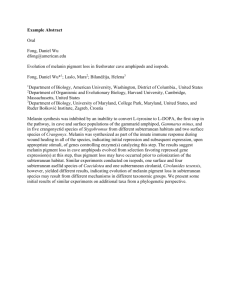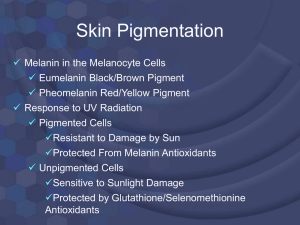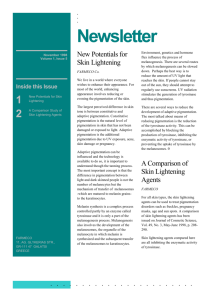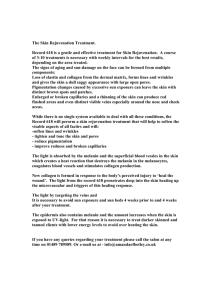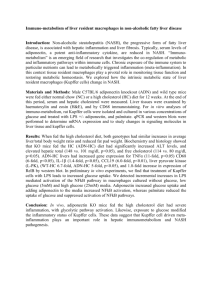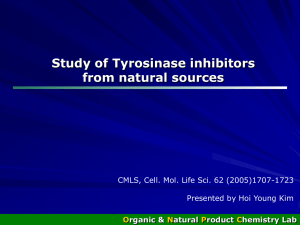The melanogenic system of the liver pigmented macrophages of
advertisement
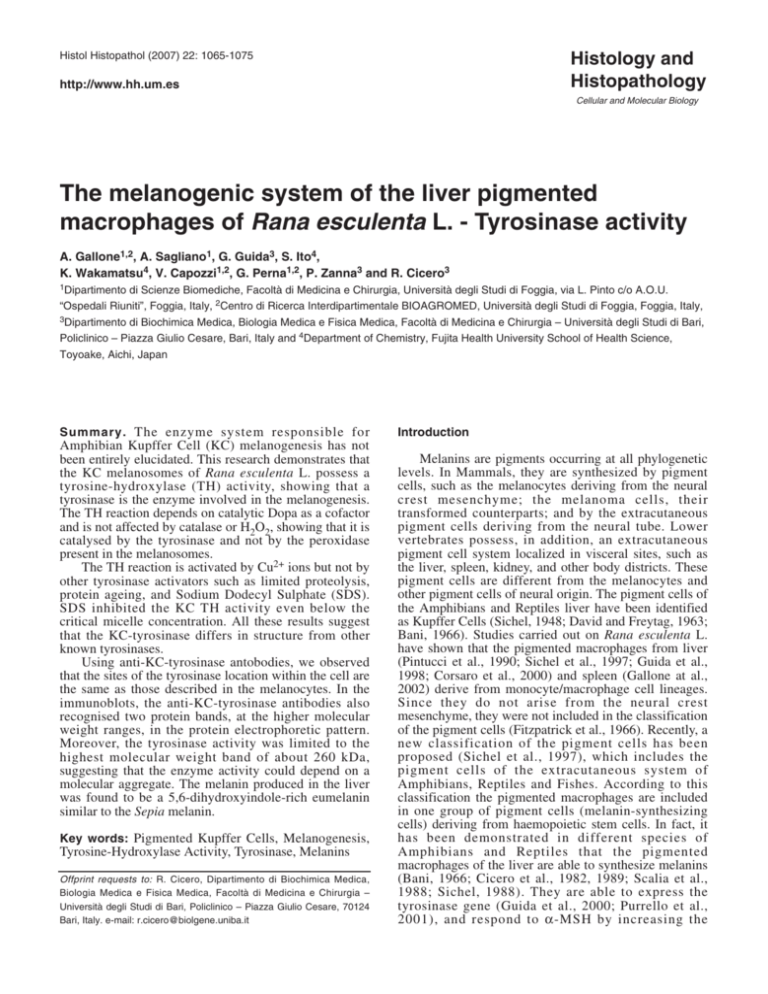
Histology and Histopathology Histol Histopathol (2007) 22: 1065-1075 http://www.hh.um.es Cellular and Molecular Biology The melanogenic system of the liver pigmented macrophages of Rana esculenta L. - Tyrosinase activity A. Gallone1,2, A. Sagliano1, G. Guida3, S. Ito4, K. Wakamatsu4, V. Capozzi1,2, G. Perna1,2, P. Zanna3 and R. Cicero3 1Dipartimento di Scienze Biomediche, Facoltà di Medicina e Chirurgia, Università degli Studi di Foggia, via L. Pinto c/o A.O.U. “Ospedali Riuniti”, Foggia, Italy, 2Centro di Ricerca Interdipartimentale BIOAGROMED, Università degli Studi di Foggia, Foggia, Italy, 3Dipartimento di Biochimica Medica, Biologia Medica e Fisica Medica, Facoltà di Medicina e Chirurgia – Università degli Studi di Bari, Policlinico – Piazza Giulio Cesare, Bari, Italy and 4Department of Chemistry, Fujita Health University School of Health Science, Toyoake, Aichi, Japan Summary. The enzyme system responsible for Amphibian Kupffer Cell (KC) melanogenesis has not been entirely elucidated. This research demonstrates that the KC melanosomes of Rana esculenta L. possess a tyrosine-hydroxylase (TH) activity, showing that a tyrosinase is the enzyme involved in the melanogenesis. The TH reaction depends on catalytic Dopa as a cofactor and is not affected by catalase or H2O2, showing that it is catalysed by the tyrosinase and not by the peroxidase present in the melanosomes. The TH reaction is activated by Cu2+ ions but not by other tyrosinase activators such as limited proteolysis, protein ageing, and Sodium Dodecyl Sulphate (SDS). SDS inhibited the KC TH activity even below the critical micelle concentration. All these results suggest that the KC-tyrosinase differs in structure from other known tyrosinases. Using anti-KC-tyrosinase antobodies, we observed that the sites of the tyrosinase location within the cell are the same as those described in the melanocytes. In the immunoblots, the anti-KC-tyrosinase antibodies also recognised two protein bands, at the higher molecular weight ranges, in the protein electrophoretic pattern. Moreover, the tyrosinase activity was limited to the highest molecular weight band of about 260 kDa, suggesting that the enzyme activity could depend on a molecular aggregate. The melanin produced in the liver was found to be a 5,6-dihydroxyindole-rich eumelanin similar to the Sepia melanin. Key words: Pigmented Kupffer Cells, Melanogenesis, Tyrosine-Hydroxylase Activity, Tyrosinase, Melanins Offprint requests to: R. Cicero, Dipartimento di Biochimica Medica, Biologia Medica e Fisica Medica, Facoltà di Medicina e Chirurgia – Università degli Studi di Bari, Policlinico – Piazza Giulio Cesare, 70124 Bari, Italy. e-mail: r.cicero@biolgene.uniba.it Introduction Melanins are pigments occurring at all phylogenetic levels. In Mammals, they are synthesized by pigment cells, such as the melanocytes deriving from the neural crest mesenchyme; the melanoma cells, their transformed counterparts; and by the extracutaneous pigment cells deriving from the neural tube. Lower vertebrates possess, in addition, an extracutaneous pigment cell system localized in visceral sites, such as the liver, spleen, kidney, and other body districts. These pigment cells are different from the melanocytes and other pigment cells of neural origin. The pigment cells of the Amphibians and Reptiles liver have been identified as Kupffer Cells (Sichel, 1948; David and Freytag, 1963; Bani, 1966). Studies carried out on Rana esculenta L. have shown that the pigmented macrophages from liver (Pintucci et al., 1990; Sichel et al., 1997; Guida et al., 1998; Corsaro et al., 2000) and spleen (Gallone at al., 2002) derive from monocyte/macrophage cell lineages. Since they do not arise from the neural crest mesenchyme, they were not included in the classification of the pigment cells (Fitzpatrick et al., 1966). Recently, a new classification of the pigment cells has been proposed (Sichel et al., 1997), which includes the pigment cells of the extracutaneous system of Amphibians, Reptiles and Fishes. According to this classification the pigmented macrophages are included in one group of pigment cells (melanin-synthesizing cells) deriving from haemopoietic stem cells. In fact, it has been demonstrated in different species of Amphibians and Reptiles that the pigmented macrophages of the liver are able to synthesize melanins (Bani, 1966; Cicero et al., 1982, 1989; Scalia et al., 1988; Sichel, 1988). They are able to express the tyrosinase gene (Guida et al., 2000; Purrello et al., 2001), and respond to α-MSH by increasing the 1066 Tyrosinase of R. esculenta Kupffer cells tyrosinase gene transcripts (Guida et al., 2004). Previous enzymatic studies have shown that the melanosomes of the pigmented macrophages from the liver and spleen of R. esculenta L. possess dopaoxidase and peroxidase activities, which feature peculiar characteristics (Gallone et al., 2002). The dopaoxidase activity appears to be directly related with the liver melanogenesis because its activity levels vary seasonally, in parallel with the liver melanin content (Cicero et al., 1977; Corsaro et al., 1990), showing maximum levels in winter and minimum in summer. As regards the tyrosine-hydroxylase activity, although autoradiographic or cytological analyses have suggested its presence in the pigmented macrophages (Cicero et al., 1982; Sichel et al., 1997), attempts to clearly evidence this activity on protein extracts from melanosomes were not always successful. The functional role of the melanins in the visceral organs of the lower vertebrates has long been discussed (Sichel, 1988; Agius and Roberts, 2003, for reviews). Generally, authors attribute the presence of black-brown melanins to cytoprotective functions against cytotoxic chemical species generating stress conditions (Geremia et al., 1984; Sarna et al., 1986; Scalia et al., 1990). Some authors have drawn a relationship between the activation of visceral melanogenesis and particular metabolic states in animals, such as the decline of anti-oxidant enzymatic activities during hibernation (Barni et al., 1999), and experimentally induced hypoxia (Frangioni et al., 2000). The aim of the present research is to study the enzyme responsible for the melanogenic ability of the Kupffer Cells of the frog Rana esculenta L. in order to better understand the mechanism which triggers the melanogenesis reaction. Tyrosinase is the key enzyme of the melanin pathway which catalyses two different reactions: 1) the hydroxylation of monophenols to odiphenols (monophenolase or cresolase activity EC 1.14.18.1), and 2) the oxidation of o-diphenols to oquinones (diphenolase or catechol oxidase activity EC 1.10.3.1). The above functions were defined by Raper (1927), Mason (1948), Lerner et al. (1949). The evidence of a tyrosine-hydroxylase activity beside the dopaoxidase activity, shown in a previous research (Cicero et al., 1989), would confirm the existence of a tyrosinase in the pigmented Kupffer Cells of R. esculenta. With this aim, we performed experiments to search for the presence of a tyrosine-hydroxylase activity in these cells. Vertebrate tyrosinase is a glycoprotein of the melanosome membrane, and its biogenesis steps have been shown in melanocytes, as well as in melanoma cells (Orlow, 1998, for a review). In the present study we have also tried to detect the sites of tyrosinase location within the Kupffer Cells, to better understand the enzyme processing path. Finally, to gain a more extensive knowledge of the liver pigment system, we carried out chemical characterization of the melanin synthesized by the Kupffer Cells, using the HPLC microanalytical methods of Wakamatsu and Ito, 2002. Materials and methods Source of the material Experiments were carried out on wild specimens of Rana esculenta L. randomly collected near Catania (Sicily) at monthly intervals. The liver from at least 50 animals (an average of 30 g of tissue) was minced and homogenized in a Potter Elvejem homogenizer in a 0.05 M Na-phosphate buffer, pH 7.2, on ice. Melanosome protein isolation was performed following the method of Cicero et al. (1989), with minor modifications. 0.1 mM phenylmethylsulphonyl fluoride (PMSF) (Sigma Chemical Co, St Louis, MO, USA) was used as protease inhibitor. The protein content was determined by the “Bio-Rad Protein Assay “ kit according to the Bradford method (1976) and then used for enzymatic assays. All the assays were performed on dialysed or not dialysed samples. Dialyses were performed over-night in 0.05 M, pH 7.2 phosphate buffer at 4°C. Since the attempts to purify the enzyme always produced loss of activity, we used the crude melanosome protein extracts for this study. Biochemical experiments Tyrosine-hydroxylase (TH) activity (EC 1.14.18.1). Assays of the TH activity were carried out with a double beam Perkin Elmer Lambda-5 Spectrophotometer, at a constant temperature of 25°C, following the dopachrome formation at 475 nm (Mason, 1948). The TH activity was determined on 700 µ g of melanosome proteins suspended in a 0.1 M Na-phosphate buffer, pH 6.8. The reaction was started by adding L-tyrosine (Sigma) at a final concentration of 1 mM, and catalytic amounts of LDopa at a final concentration ranging from 5 µM, 10 µ M, to 25 µ M, in a volume of 0.5 ml. The 10 µ M concentration of catalytic L-Dopa was chosen for the routine analyses. The velocity of product formation was registered in a time drive mode. The reaction was also recorded by spectrophotometer scanning of the samples from 200 nm to 600 nm, at 1-hour intervals for at least 20 cycles. Peroxidase (POD) activity (EC 1.11.1.7). POD activity was determined using p-phenylenediamine-pyrocatechol (PPD-PC) substrates. The reaction mixture contained 40 µ g of melanosome proteins in a 0.1 M K-phosphate buffer pH 6.5, plus 0.17 mM PPD (Sigma) and 4.5 mM PC (Sigma) in a volume of 500 µl. The reaction was started by adding 250 µ M H 2 O 2 . The absorbance increase was measured at 575 nm (Imberty et al., 1984). Inhibition experiments. The following inhibitors were used: KCN, at a final concentration of 4 or 6 mM; PTU (phenylthiourea) at a final concentration of 4 mM . Heat inactivation. Heat inactivation was performed by boiling aliquots of the melanosome proteins at 100°C for 15 min. Catalase (EC 1.11.1.6) treatment. Melanosome proteins were incubated with 1000 or 2000 E.U. catalase 1067 Tyrosinase of R. esculenta Kupffer cells (Sigma), for 60 min at room temperature before the assay. H2O2 treatment. TH activity was assayed in the presence of 250 µ M or 500 µ M H 2 O 2 , added to the reaction mixture, with melanosome proteins, just before the tyrosine. CuSO 4 activation. Aliquots of dialysed melanosome proteins were incubated in the presence of various concentrations of CuSO4, for times ranging from 10 min to 60 min, at room temperature. The TH activity was assayed using the dopachrome method. To exclude unspecific responses due to possible interactions between substrates and other components of the reaction mixture, measurements of absorbance at 475 nm were made on mixtures only composed of tyrosine and/or LDopa + CuSO4. Melanosome proteins + CuSO4 without substrates were also assayed. Proteolysis. The melanosome proteins were incubated with trypsin at various concentrations (from 0.0001 to 0.1 %) in a Na- phosphate buffer pH 7.2, at 37°C, for increasing times: 1 min – 30 min. After incubation, samples were assayed for the TH activity. Protein ageing. Aliquots of melanosome protein, freshly extracted, were left for a week in a refrigerator, at 4°C. Aliquots of protein were taken each day and assayed for the TH activity. Sodium Dodecyl Sulphate (SDS) treatment. The melanosome proteins underwent different treatments with SDS at 0.01%, 0.02%, 0.05%, 0.1%, 1%. SDS was added to the melanosome protein in the reaction mixture immediately before the tyrosine. The reaction was recorded for at least one hour at 475 nm. In other experiments, samples were incubated for 10 - 15 min with SDS before the assay. Polyacrylamide-gel-electrophoresis (PAGE) The melanosome proteins and mushroom tyrosinase (Sigma), as a positive control, were subjected to PAGE (Laemmli, 1970). To evidence the enzymatic activity, samples (25 µ g of melanosome proteins or 20 µ g of mushroom tyrosinase) were diluted twice in a sample buffer not containing SDS and separated on polyacrylamide (PAA) gels (Bio-Rad, Richmond, CA, USA) 8% + 0.1% SDS, at 4°C. The gel was equilibrated in Na-phosphate 0.05 M, pH 6.8 buffer, at 25°C for 30 min. The dopaoxidase (DO) reaction on gel was performed in the presence of 4 mM L-Dopa in a Naphosphate buffer 0.05 M, pH 6.8, at room temperature overnight. After testing for dopa positivity, the same PAA gel was extensively washed in Na-phosphate buffer 0.05 M and stained with Coomassie Brilliant Blue R250 (Bio-Rad). Blue Ranger molecular weight markers (PIERCE, Rockford, IL, US) were included in all gels. Preparation of the anti-KC-tyrosinase antibodies Anti-KC-tyrosinase antibodies were prepared following the method of Guida et al. (2004). In brief, using a fragment of KC-tyrosinase gene of Rana esculenta highly homologous (94%) with the exon I sequence of the skin tyrosinase of Rana nigromaculata (Takase et al., 1992), a 15 amino acid oligopeptide was synthesized and used to obtain polyclonal rabbit antibodies, prepared by Genosys Sigma-Aldrich Ltd, London, UK. The oligopeptide sequence was published by Guida et al. (2004). The presence of antibodies against the oligopeptide as well as their specific recognition by the immunized rabbit serum, in comparison to the pre-immunized serum, was demonstrated by ELISA analysis following a routine protocol. Western-blotting The anti-KC-tyrosinase antiserum was used to perform immunoblotting of the protein component of liver melanosomes. Samples were diluted twice in a sample buffer, without SDS, and then loaded on 8% PAA gels. The proteins were separated in Tris-Glycine buffer containing 0.1% SDS and then transferred onto 0.45 µ m nitrocellulose membranes, blotted in PBS containing Tween-20 0.1% and supplemented with 5% milk (Bio-Rad). The membrane was first incubated with the anti-KC-tyrosinase antiserum (diluted 1/1000) overnight at 4°C and then with a peroxidase-labeled secondary antibody (diluted 1/5000). Incubation was carried out at room temperature for one hour. The Super Signal West-Pico Chemiluminescent Substrate (PIERCE) was used for detection. Immunogold staining Fragments of liver tissue were fixed with 2% paraformaldehyde,1% glutaraldehyde (TAAB Lab Equipment Ltd, Reading, England) in PBS, dehydrated in ethanol and embedded in LR White resin (Sigma). The immuno-recognition reaction, by antibodies conjugated to 10 nm particles of colloidal gold, was performed on ultra-thin sections mounted on nickel grids. The anti-KC-tyrosinase antiserum was used at a dilution of 1/100. Chemical analysis of the liver melanin For this purpose, only adult specimens of frogs fished in winter were used. Liver melanosomes were isolated as indicated above. A partial purification of melanin was carried out by incubating the melanosomes with 1% BRIJ-35 in 0.1 M Na-phosphate buffer, pH 7.2, overnight at 4°C. Then the suspension was centrifuged at 22000xg for 60 min, at 4°C, and the melanin recovered with the pellet. One hundred µg of dry melanin was oxidized with KMnO4 in 1 M H2SO4, and the oxidized material was analyzed for pyrrole-2,3,5-tricarboxylic acid (PTCA) (Ito and Fujita, 1985; Ito and Wakamatsu, 1998; Liu et al., 2003). Pyrrole-2,3-dicarboxylic acid (PDCA) was 1068 Tyrosinase of R. esculenta Kupffer cells produced only in a trace quantity. The melanin (200 µg) was also oxidized with H2O2 in alkali to form PTCA and PDCA. PTCA serves as a specific degradation product for DHICA-derived units while PDCA serves for DHI-derived units (Ito and Wakamatsu, 1998). Hydriodic acid (HI) hydrolysis to detect pheomelanic pigment was performed on 200 µg melanin as described in Wakamatsu et al. (2002) and Liu et al. (2003). 4-Amino-3-hydroxyphenylalanine (4-AHP) serves as a specific degradation product of pheomelanin. Soluene-350 solubilization of melanin (200 µg) was also performed to measure total melanin (TM), as described in Ozeki et al. (1995) and Liu et al. (2003). and PTU (Table 1) and by heat-inactivation (not shown). Because a peroxidase activity had been evidenced in the melanosome proteins (Gallone et al., 2002), we performed assays of the TH activity after protein incubation with catalase or H2O2. We found that neither catalase nor H2O2 significantly affected the TH reaction (Table 1). We measured the TH activity in frogs collected at different periods of the year and observed that it can be registered in the months from October to June; on the contrary, no activity is detectable in July and September. In particular, the TH activity features the same trend as Results Table 1. Tyrosine-hydroxylase activity assayed on melanosome proteins from the Kupffer Cells of R. esculenta L. Values are the mean of four measurements. Tyrosine-hydroxylase activity Proteins extracted from the Kupffer Cell melanosomes show a very low TH activity (Table 1). The reaction shows a lag-phase of approximately one and a half hours (Fig. 1a), reduced by the addition of catalytic quantities of L-Dopa (Fig. 1b, Table 1). Figure 2 shows spectra recorded during a 20 hour reaction of a mixture of melanosome proteins and L-tyrosine. The absorbance increase at all analyzed wavelengths suggests that melanin-like pigment is produced during the 20-hour reaction. The reaction is inhibited by KCN Melanosome Proteins Tyrosine-hydroxylase Activity (∆A475/min x mg prot.) ± SD JANUARY 20051 L-Tyr 1 mM L-Tyr 1 mM + L-Dopa 10 µM KCN 6 mM PTU 4 mM Catalase 2000 E.U. H2O2 500 µM (1.40±0.07) x 10-4 (3.00±0.15) x 10-4 0.0 0.0 (1.60±0.08) x 10-4 (1.40±0.07) x 10-4 JULY 20042 L-Tyr 1 mM L-Tyr 1 mM + L-Dopa 10 µM 0.0 0.0 1: Samples can be activated by CuSO ; 2: Samples cannot be activated 4 by CuSO4; SD: standard deviation. Fig. 1. Lag-phase of the frog Kupffer Cell melanosome tyrosinehydroxylase reaction in the absence (a) and in the presence (b) of catalytic L-Dopa. Reaction mixture contains: 700 µg melanosome proteins suspended in a 0.1 M Na-phosphate buffer, pH 6.8 + 1 mM Ltyrosine and 10 µM L-Dopa, in a volume of 0.5 ml. λ: 475 nm. Fig. 2. Optical spectra recorded during a 20 hour reaction of a mixture of 700 µg melanosome proteins suspended in a 0.1 M Na-phosphate buffer, pH 6.8 + 1 mM L-tyrosine, in a volume of 0.5 ml. Abscissa: λ: from 200 to 600 nm. Ordinate: Absorbance. 1069 Tyrosinase of R. esculenta Kupffer cells the DO activity, showed by Cicero et al. (1989). Table 1 presents the values of TH activity recorded in two periods of the year, demonstrating the activity-inactivity of the system. Activation experiments Because the TH activity is always very low, we carried out some activation experiments on the proteins extracted from melanosomes. High values of TH activity were found after incubating the melanosome protein with CuSO4. Fig. 3 shows the dependence of the TH activation on the Cu2+ ions concentration. All the controls made to ascertain the specificity of the activation showed that the absorbance variation at 475 nm does not depend on unspecific interactions among the components of the reaction mixture. The reaction is totally inhibited by KCN. In previous studies we have demonstrated that the DO activity of the frog Kupffer Cells is also activated by Cu 2+ ions (Cicero et al., 1990). It is interesting to observe that TH activity, like DO activity, does not respond to treatments with CuSO4 in all months of the year. In fact, it is impossible to activate TH activity in the months from July to September, when this activity is not detectable (Table 1). For a comparison with the melanocyte tyrosinase, we also performed treatments that are able to activate this activity; such as, 1) limited proteolysis, 2) ageing of the protein, and 3) the action of SDS (Penafiel et al., 1982; Wittenberg and Triplett, 1985a,b; Zuasti et al., 1998; Lopez-Serrano et al., 2002). Limited proteolysis of the melanosome proteins did not produce increases of TH activity; on the contrary it caused a complete disappearance of the activity even at very low concentrations of trypsin (0.0001%). Nor did ageing of the melanosome protein, at 4°C in the refrigerator, produce any activation of TH. The samples remained stable for the first four days of treatment and subsequently began to lose their activity. After six days in the refrigerator they had little or no activity, unlike the skin tyrosinase (Zuasti et al., 1998). Treatment of the protein with various concentrations of SDS did not produce any activation of the TH reaction too. On the contrary, it invariably suppressed it, even at the concentration of 0.02% which is lower than the critical micelle concentration, activating tyrosinases or other polyphenol oxidases (Wittenberg and Triplett, 1985a,b; Lopez-Serrano et al., 2002). Cell location of the hepatic tyrosinase by immuno-gold We endeavoured to highlight the sites of tyrosinase localization in the Kupffer Cells using immuno-gold techniques. Figure 4 shows cell fields where there is evident recognition by the anti-KC-tyrosinase antibodies. In Figure 4a, the grains of the colloidal gold appear localized, alone or in small groups, inside the rough endoplasmic reticulum (RER), the Golgi vescicles, and the Trans-Golgi-Network; in Figure 4b and c, the grains of the colloidal gold appear localized within cytoplasmic vescicles, as well as on the surface of the melanosomes and premelanosomes. Polyacrylamide-gel-electrophoresis (PAGE) The melanosome proteins were separated by PAGE under non reducing conditions and the gels were Table 2. Peroxidase activity of crude melanosome proteins from the Kupffer Cells of Rana esculenta L. Melanosome Proteins Peroxidase Activity (∆A575/min x mg prot.)±SD MARCH 2004 Melanosome protein KCN 4mM 0.12±0.0006 0.0 MAY 2004 Melanosome protein Dialysed protein Catalase 1000 E.U. 0.30±0.015 0.20±0.010 0.0 JULY 2004 Melanosome protein Dialysed melanosome protein 0.52±0.026 0.18±0.009 JANUARY 2005 Melanosome protein 0.22±0.011 Values are the mean of three measurements. SD: standard deviation. The decrease of peroxidase activity after dialysis is likely due to removal of H2O2 . Fig. 3. Increases in the tyrosine-hydroxylase activity in the melanosome proteins of the Kupffer Cells of R. esculenta L., after incubation with increasing concentrations of CuSO4 (µM), in the presence of constant concentrations of L-tyrosine (1 mM) and 700 µg of melanosome proteins, suspended in a 0.1 M Na-phosphate buffer, pH 6.8, in a volume of 0.5 ml. λ: 475 nm. The reaction is inhibited by KCN. 1070 Tyrosinase of R. esculenta Kupffer cells incubated with L-Dopa 4 mM to test the enzyme activity. Figure 5A shows that the DO activity was confined to a high molecular weight (MW) band that barely entered the separating gel, thus making an estimation of its precise size very difficult. Figure 5B shows the same gel after staining with Coomassie. An average MW of 260 kDa has been attributed to this protein band. MW of 121 kDa and another one of higher size. Comparison with the activity electrophoresis gel demonstrated that the positive reaction to L-Dopa is limited to the higher molecular weight band, i.e. the one with the apparent MW of 260 kDa, thus suggesting that the activity is dependent on the formation of an oligomeric form of the enzyme. Western-blotting Peroxidase activity Figure 6 shows the results of immuno-blotting of the melanosome proteins. The anti-KC-tyrosinase antibodies recognized two principal bands, one with an apparent We assayed the POD activity in the melanosome protein during the course of the year, for comparison to the TH activity. The results are summarized in Table 2. Fig. 4. a. Pigmented Kupffer Cell of R. esculenta L. The colloidal gold particles are localized within the RER compartment (small arrows), the Golgi vesicles and the Trans-Golgi-Network (arrows). x 100,000. b. Pigmented Kupffer Cell of R. esculenta L. The colloidal gold particles (arrows) are localized in cytoplasmic vesicles, in the cortical vesicles of the melanosomes and c: premelanosomes. x 100,000 1071 Tyrosinase of R. esculenta Kupffer cells The levels of POD activity are seen to vary over the course of the year, but with an inverse trend compared with TH activities. The POD activity is totally inhibited by KCN. Chemical analysis of the liver melanin Table 3 summarizes yields of PTCA and PDCA resulting from the oxidative degradation of the liver melanin in comparison with those of Sepia melanin and synthetic melanins. Results of HI hydrolysis to detect 4- Fig. 5. A. Melanosome proteins from Kupffer Cells of R. esculenta L. subjected to PAGE and stained for dopaoxidase activity with 4 mM LDopa. Lane1: mushroom tyrosinase; lane 2: March, and 3: May melanosome proteins. The dopa-positivity is mainly supported by the protein band with the highest weight: an average MW of 260 kDa. B. the same as A, stained with Coomassie Brilliant Blue. Fig. 6. Immuno-blotting of the melanosome protein from Kupffer Cells of R. esculenta L. The anti-KC-tyrosinase antibodies strongly recognize two principal protein bands with an apparent MW of 260 kDa and 121 kDa ( arrows). Table 3. Chemical characterization of liver melanin of R. esculenta L. in comparison with natural and synthetic melanins. Sample PTCA by KMnO4 (µg/mg) Liver melaninb Sepia melaninc LY mouse hairc, d DHI-melanine DHI+DHICA-melanine DHICA-melanine a: 0.53 5.70 0.012 2.06 12.8 24.9 PTCA by H2O2 (µg/mg) PDCA by H2O2 (µg/mg) 4-AHP by HI (µg/mg) TM by Soluene-350 (A500/mg) PTCAa/TM (µg/A500) PTCA/PDCA 4-AHP/TM 1.21 11.3 0.095 3.29 22.7 53.5 0.027 0.019 0.045 1.66 0.210 <0.04 0.042 <0.01 1.60 ND ND ND 0.77 7.09 0.10 9.41 8.09 4.67 0.69 0.80 0.12 0.22 1.58 5.33 45 59 2.1 2.0 108 >1000 0.05 <0.01 16 ND ND ND By KMnO4 oxidation. b: PTCA, PDCA, and 4-AHP values are averages of two determinations. c: Data taken from Liu et al. (2004). d: LY denotes lethal yellow. e: Data taken from Ito and Wakamatsu (1998). The unit A500/mg indicates absorbance of 500 nm of 1 mg melanin dissolved in 1 ml of Soluene-350 plus water. Actually we dissolve 0.2 mg of melanin in 1 ml and multiply the absorbance by 5. ND: not determined. 1072 Tyrosinase of R. esculenta Kupffer cells AHP and solubilization in Soluene-350 are also compared. Comparison of the PTCA/TM ratio of 0.69 (µg/A500) with those of synthetic melanins from DHI, DHI+DHICA (1:1), and DHICA indicates that the liver melanin consists of DHI and DHICA units, DHI being the major unit. The PTCA/TM ratio of the liver melanin is close to that of Sepia melanin (0.80; Liu et al., 2004). This conclusion is supported by the fact that the PTCA/PDCA ratio of 45.0 obtained by H2O2 oxidation of the liver melanin is similar to that of Sepia melanin (59.0) and is intermediate between DHI-melanin (2.0) and DHI+DHICA-melanin (108.0). Comparison of 4AHP/TM ratios between the liver melanin (0.05 µ g/A 500) and pheomelanic lethal yellow mouse hair (16.0) indicates that the liver melanin contains mostly eumelanin. The liver melanin preparation contained ca. 10% of melanin pigment as judged by the total melanin value of 0.77 (A 500/mg) in comparison with that of DHI+DHICA-melanin (8.09). Discussion This study confirms that the Kupffer Cells of R. esculenta L. possess a tyrosinase, as shown by the coexistence of both TH and DO activity in the melanosome protein. The TH activity typically shows a lag phase and depends on catalytic Dopa as a cofactor. The TH activity registered in the melanosome protein is very low, and limited to certain months of the year. Activation experiments showed that copper addition was only effective in activating the TH reaction. The activation kinetics with copper of the TH activity are similar to those shown by the DO activity (Cicero et al., 1990) and suggest that Cu2+ ions activate an apoenzymatic form of the tyrosinase. On the basis of these results it can be hypothesized that the KC tyrosinase activity depends on the cell copper ion concentration and in turn on a copper ion releasing system. It should be kept in mind that liver is involved in storage and detoxification of copper, and the functioning of the liver tyrosinase could depend, at least in part, on these metabolic events. Beltramini and Lerch (1982) have shown that Cu-metallothionein is able to mediate the transfer of copper to the Neurospora tyrosinase. Chen et al. (1992) have shown that in Streptomyces antibioticus, a trans-activator protein MelC1, can mediate the incorporation of copper into the apotyrosinase MelC2. Martinez et al. (1987) evidenced forms of apo-tyrosinase which could be activated by Cu(II) in both soluble and microsomal fractions of Harding-Passey murine melanoma cells, while active tyrosinase was limited to melanosomes. These authors suggested that the cytoplasmic copper was accumulated in the melanosomes, thus maintaining the copper concentrations at low levels. They attribute a possible regulatory role to variations of the copper concentrations. In the melanosome of the Kupffer Cells, an apoenzymatic form of tyrosinase could coexist with small quantities of an active form which would support the low basic levels of activity. The lack of both the TH and DO (Cicero et al.,1990) activities in summer, coinciding with a very low content of liver melanin (Cicero et al., 1977; Corsaro et al.,1990), as well as the unresponsiveness of the system to copper addition, could be related either to an absence of the enzyme or to melanogenesis inactivation events, whose mechanism is at present unknown. Other attempts to activate the KC tyrosinase were unsuccessful. The apoenzymatic form of skin tyrosinases from numerous vertebrate species is activated by proteolytic removal of an inhibitor peptide (GarciaBorron et al., 1982; Peñafiel et al., 1982; Valverde et al., 1992). The observation that the KC tyrosinase is inactivated by limited proteolysis suggests that the apoenzymatic form of these cells could be structurally different from that of the melanocytes, and proteolysis could damage functional parts of the enzyme, suppressing its activity. The negative results of the protein ageing, which would also affect removal of the inhibitor from the apo-tyrosinase form, are in agreement with this view, too. The response of TH activity to SDS treatments shows differences between the KC tyrosinase and other known tyrosinases, too. It has been demonstrated in some skin tyrosinases, as well as in other polyphenol oxidases, that SDS and other anionic detergents are able to activate their catalytic functions (Wittenberg and Triplett, 1985a,b; Lopez-Serrano et al., 2002). The activation mechanism is exerted by the detergent in a monomer status, under the critical micelle concentration (0.7 mM SDS, corresponding to the 0.02% concentration), but not as a micellar aggregate, above the critical micelle concentration. Our results show that the KC tyrosinase is totally inhibited by SDS at all concentrations tested. All these results strongly suggest that structural differences between the KC tyrosinase and the other known tyrosinases exist, accounting for its peculiar chemical-physical behaviour. Immuno-blots of the melanosome protein show that the anti-KC-tyrosinase antibodies recognise two principal bands in the higher molecular weights range (Fig. 6). By comparing the immuno-blotting patterns to those of the activity test on PAGE (Fig. 5) it can be observed that the dopaoxidase activity is only manifested by the protein band with the highest molecular weight, among the two bands recognized by the antibodies. This result strongly indicates that the enzyme activity could depend on the formation of a molecular aggregate. In this respect, it is possible that the SDS inhibitory effects could be exerted through disaggregation of an active macromolecular complex. It has been demonstrated in mammalian melanocytes (Kobayashi et al., 1998) and melanoma cells (JiménezCervantes et al., 1998) that the catalytic functions of tyrosinase depend on a multi-enzymatic complex, and that Tyrp1 (tyrosinase related protein-1) participates in its formation. The tyrosinase system of pigmented macrophages seems to act similarly, in respect to a catalytically active molecular aggregate formation. The results of immuno-gold-recognition experiments 1073 Tyrosinase of R. esculenta Kupffer cells are also in accord with the presence of a tyrosinase in the Kupffer Cells of R. esculenta. In fact, when used on the ultra-thin sections (Fig. 4) the KC-tyrosinase antibodies recognise RER elements, Golgi vesicles, trans-Golgi network, as well as premelanosomes and melanosomes; i.e., all the cell compartments involved in the stages of tyrosinase biogenesis described in melanocytes and melanoma cells (Orlow, 1998, for a review). The results are also in harmony with other research describing the sites of tyrosine incorporation by the Kupffer Cells of amphibian species (Sichel et al., 1997). Attempts to purify the enzyme cause loss of activity. For this reason it was necessary to use the crude melanosome proteins for the analyses. The use of crude melanosomal extracts poses the problem of the coexistence of enzyme activities that may interfere with tyrosinase, including peroxidase (Gallone et al., 2002). Peroxidases have been shown to be able to catalyse the TH activity in various systems, such as those of the Saepia officinalis ink sac (Palumbo and Jackson, 1995), human eosinophils and neurons, as well as murine melanoma cells (Okun et al., 1974, 1982; Okun,1997). Assays of POD activity in liver melanosome protein, over a period of one year, have shown that the levels of the POD activity vary seasonally and with an inverse trend to both the TH activity (Table 2) as well as the melanin content of the liver (Cicero et al., 1977; Corsaro et al., 1990). These results together with the observation that TH activity is not affected by either catalase nor H 2O 2, suggest that: 1) the POD activity and the TH activity are supported by different enzymes following an inverse trend of seasonal variation in their activity levels; 2) the TH activity is catalysed by the tyrosinase and not by the peroxidase present in the Kupffer Cell melanosomes. Schraermeyer and Stieve (1994) showed that tyrosinase and peroxidase co-exist in secondary lysosomes of the retinal pigmented epithelium (RPE) degrading the shedded photoreceptors membranes. As is known, melanosomes are thought to be lysosome derivatives. Though the pigmented KCs are ontogenetically distant from the RPE, both cell types carry out phagocytosis and exert protective functions towards generated stress conditions. The roles played by peroxidase in the melanosomes of the pigmented KCs remain to be clarified. The macrophage pigment system is still poorly known as far as the melanin structural organization is concerned. The possibility of understanding the function of melanins also depends on a better knowledge of its structure. Study of the chemical structure of the melanin is mostly based on analyses of its oxidation and reduction products (Piattelli et al., 1962; Nicolaus et al., 1964; Ito, 1998; Wakamatsu and Ito, 2002). Chemical analysis of melanins present in amphibian liver were first reported by Nicolaus et al. (1964). They identified PTCA and PDCA among permanganate oxidation products of the melanins from Amphiuma and Axolotl (Urodeles) liver. On the basis of their results they classified the liver melanin as “indole” melanin. Corsaro et al. (1975) obtained similar results in the liver melanin from R. esculenta L. Sciuto et al. (1988) further demonstrated differences in the elemental composition of the liver and skin melanin of R. esculenta, and in turn, of the synthetic dopa-melanin. These authors affirm that both the skin and the liver melanins are eumelanin. In the present study we have demonstrated that the liver melanin synthesized by the frog Kupffer Cells is mostly composed by a DHI-rich eumelanin showing characteristics very similar to those of the Sepia melanin. In a recent work Frangioni et al. (2005) report the results of an elemental analysis of melanin extracted by oxidative bleaching of liver fragments from hypoxic specimens of the newt Triturus cristatus carnifex (Laurenti)(Urodeles). These authors affirm that the C/N ratio differs from that of a pure indole-melanin, because of a very low carbon content. Nicolaus et al. (1964) reported that the liver melanin of the Urodeles Amphiuma and Axolotl is an indole melanin, which is in accordance with the results of the present chemical analysis, carried out on liver melanin of frog, as well as with previous results of Corsaro et al. (1975) and Sciuto et al. (1988). Taking into account the above data, the differences reported by Frangioni et al. (2005) cannot be imputable to the phylogenic distance between the two orders of Amphibians. Frangioni et al. (2005) hypothesize that, in the hypoxic animals, melanin may entrap purine molecules deriving from the destroyed red blood cells. Unfortunately, the authors do not report the elemental analysis of the normoxic animals, so preventing a comparison between normoxic and hypoxic conditions. In addition, the different extractive methods used prevent a comparison between the results of Frangioni et al. (2005) and the results of the present chemical analysis, as well as with those of Nicolaus et al. (1964), Corsaro et al. (1975) and Sciuto et al. (1988). In previous works, we studied the structure of liver melanins using Raman Spectroscopy and photoluminescence methods, in order to identify the structure of melanin monomer/s in their native form, as well as the biopolymer organization (Capozzi et al., 2005; Perna et al., 2005). We demonstrated that liver melanins mainly contain indolic units, consistently with the present chemical analysis, and that the polymer organization can be described as a network of nanoclusters of different sizes. In this respect liver melanins show some features in common with theoretical models (Powell et al., 2004) and are in good accordance (unpublished data) with the structural model of the sepiomelanin proposed by Clancy et al. (2000). In conclusion, all the results of this work demonstrate that the liver pigment system of R. esculenta, formed by Kupffer Cells, depends on a tyrosinase accounting for their melanogenic ability. This tyrosinase shows differences both at the structural and regulatory levels from those of a “typical” tyrosinase. The melanin itself shows chemical and structural 1074 Tyrosinase of R. esculenta Kupffer cells characteristics more similar to those of the Sepia melanin than those of the melanocyte melanin, indicating the phylogenic distance between the pigmented Kupffer Cells deriving from haemopoietic stem cells, and the melanocytes deriving from the neural crest mesenchyme. Acknowledgements. This study was supported by grants from University of Bari (Fondi di Ateneo, Ricerca scientifica) and University of Foggia (Fondi di Ateneo: "Quota progetti"). We would like to thank Dr. T. Bleve and Dr. M.T. Melillo of the "Istituto per la protezione delle piante"- CNR Bari, for their hospitality at the Electron Microscopy Laboratory, and Mr R. Lerario for his technical assistance. SI and KW are supported in part by Grant-in-Aid for Scientific Research 16591122 from the Ministry of Education, Culture, Sports, Science, and Technology of Japan. References Agius C. and Roberts R.J. (2003). Melano-macrophage centres and their role in fish pathology. J. Fish Disease 26, 499-509. Bani G. (1966). Melanogenesi in cellule di Kupffer di Bufo bufo (L.) adulto. Boll. Zool. 33, 269- 282. Barni S., Bertone V., Croce A.C., Bottiroli G., Bernini F. and Gerzeli G. (1999). Increase in liver pigmentation during natural hibernation in some amphibians. J. Anat. 195, 19-25. Beltramini M. and Lerch K. (1982). Copper transfer between Neurospora copper metallothionein and type 3 copper apoproteins. FEBS Lett. 142, 219-222. Bradford M. (1976). A rapid and sensitive method for the quantitation of microgram quantities of protein utilizing the principle of protein-dye binding. Anal. Biochem. 72, 248-254. Capozzi V., Perna G., Gallone A., Biagi P.F., Carmone P., Fratello A., Guida G., Zanna P., Cicero R. (2005). Raman and optical spectroscopy of eumelanin films. J. Mol. Structure 744-747, 717721. Chen L.Y., Leu W.M., Wang K.T. and Lee Y.H. (1992). Copper transfer and activation of the Streptomyces apotyrosinase are mediated through a complex formation between apotyrosinase and its transactivator MelC1. J. Biol. Chem. 267, 20100-20107. Cicero R., Corsaro C., Sichel G. and Chillemi R. (1977). Correlazione fra variazioni di melanine epatiche e cutanee e variazioni stagionali. Boll. Soc. Ital. Biol. Sper. 53, 1772-1777. Cicero R., Gallone A., Maida I. and Pintucci G. (1990). Effects of copper on the tyrosinase of liver pigment cells from Rana esculenta L. Comp. Biochem. Physiol. 96B, 393-397. Cicero R., Mallardi A., Maida I., Gallone A. and Pintucci G. (1989). Melanogenesis in the pigment cells of Rana esculenta L. liver: evidence for tyrosinase-like activity in the melanosome protein fraction. Pigment Cell Res. 2, 100-108. Cicero R., Sciuto S., Chillemi R. and Sichel G. (1982). Melanosynthesis in the Kupffer cells of amphibia. Comp. Biochem. Physiol. 73A, 477479. Clancy C.M.R., Nofsinger J.B., Hanks R.K. and Simon J.D. (2000). A hierarchical self-assembly of eumelanin. J. Phys. Chem. B, 104, 7871-7873. Corsaro C., Sciuto S. and Sichel G. (1975). Caratterizzazione e studio dell’origine di melanine, isolate da fegato e cute di Rana esculenta L. Boll. Soc. It. Biol. Sper. 51, 1663-1669. Corsaro C., Scalia M., Sinatra F. and Sichel G. (1990). Circannual rhythm of the melanin content in frog liver (Rana esculenta L.). Pigment Cell Res. 3, 120-122. Corsaro C., Scalia M., Leotta N., Mondio F. and Sichel G. (2000). Characterisation of Kupffer Cells in some Amphibia. J. Anat. 196, 249-261. David H. and Freytag G.E. (1963). Submikroskopische Befunde an der Urodelenleber. Acta Biol. Med. Ger. 10, 663-672. Fitzpatrick T.B., Quevedo W.C. Jr., Levene A.L., Mc Govern V.J., Mishima Y. and Oettle A.G. (1966). Terminology of vertebrate melanin-containing cells: 1965. Science 152, 88-89. Frangioni G., Borgioli G., Bianchi S. and Pillozzi S. (2000). Relationships between hepatic melanogenesis and respiratory conditions in the newt, Triturus carnifex. J. Exp. Zool. 287, 120-127. Frangioni G., Santoni M., Bianchi S., Franchi M., Fuzzi G., Marcaccini S., Varlani C. and Borgioli G. (2005). Function of the hepatic melanogenesis in the newt, Triturus carnifex. J. Exp. Zool. 303A, 123-131. Gallone A., Guida G., Maida I. and Cicero R. (2002). Spleen and liver pigmented macrophages of Rana esculenta L. A new melanogenic system ? Pigment Cell Res. 15, 32-40. Garcia-Borron J.C., Escribano J., Jimenez M. and Iborra J.L. (1982). Quantitative determination of tryptophanyl and tyrosyl residues of proteins by second-derivative Fluorescence Spectroscopy. Anal. Biochem. 125, 277-285. Geremia E., Corsaro C., Bonomo R., Giardinelli R., Pappalardo P., Vanella A. and Sichel G. (1984). Eumelanins as free radicals trap and superoxide dismutase activities in Amphibia. Comp. Biochem. Physiol. 79B, 67-69. Guida G., Gallone A., Maida I., Boffoli D. and Cicero R. (2000). Tyrosinase gene expression in Kupffer Cells of Rana esculenta L. Pigment Cell Res. 13, 431-435. Guida G., Maida I., Gallone A., Boffoli D. and Cicero R. (1998). Ultrastructural and functional study of the liver pigment cells from Rana esculenta L. In Vitro Cell. Dev. Biol. Animal 34, 393-400. Guida G., Zanna P., Gallone A., Argenzio E. and Cicero R. (2004). Melanogenic response of the Kupffer Cells of Rana esculenta L. to melanocyte stimulating hormone. Pigment Cell Res. 17, 128-134. Imberty A., Goldberg R. and Catesson A.M. (1984). Tetramethylbenzidine and p-phenylenediamine-pyrocatechol for peroxidase histochemistry and biochemistry: two new, non–carcinogenic chromogens for investigating lignification process. Plant Sci. Lett. 35, 103-108. Ito S. (1998). Advances in chemical analysis of melanins. In: The pigmentary system. Physiology and pathophyisiology. Nordlund J.J., Boissy R.E., Hearing V.J., King R.A and Ortonne J.P. (eds). Oxford University Press. New York. pp 439-449. Ito S. and Fujita K. (1985). Microanalysis of eumelanin and pheomelanin in hair and melanoma by chemical degradation and liquid chromatography. Anal. Biochem. 144, 527-536. Ito S. and Wakamatsu K. (1998). Chemical degradation of melanins: application to identification of dopamine-melanin. Pigment Cell Res. 11, 120-126. Jiménez-Cervantes C., Martinez-Esparza M., Solano F., Lozano J.A. and Garcia-Borron J.C. (1998). Molecular interactions within the melanogenic complex: formation of heterodimers of tyrosinase and TRP1 from B16 mouse melanoma. Biochem. Biophys. Res. Commun. 253, 761-767. Kobayashi T., Imokawa G., Bennett D.C., and Hearing V.J. (1998). 1075 Tyrosinase of R. esculenta Kupffer cells Tyrosinase stabilization by Tyrp1 (the brown Locus Protein). J. Biol. Chem. 273, 31801-31805. Laemmli U.K. (1970). Cleavage of structural proteins during the assembly of the head of bacteriophage T4. Nature 227, 680-684. Lerner A.B., Fitzpatrick T.B., Calkins E., Summerson W.H. (1949). Mammalian tyrosinase – preparation and properties. J. Biol. Chem. 178, 185-195. Liu Y., Hong L., Kempf V.R., Wakamatsu K., Ito S. and Simon J.D. (2004). Ion-exchange and adsorption of Fe(III) by Sepia melanin. Pigment Cell Res. 17, 262-269. Liu Y., Kempf V.R., Nofsinger J.B., Weinert E.E., Rudnicki M., Wakamatsu K., Ito S. and Simon J.D. (2003). Comparison of the structural and physical properties of human hair eumelanin following enzymatic or acid/base extraction. Pigment Cell Res. 16, 355-365. Lòpez-Serrano D., Sanchez-Amat A. and Solano F. (2002). Cloning and molecular characterization of a SDS-activated tyrosinase from Marinomonas mediterranea. Pigment Cell Res. 15, 104-111. Martinez J.H., Solano F., Arocas A. Garcia-Borron J.C., Iborra J.L. and Lozano J.A. (1987). The existence of apotyrosinase in the cytosol of Harding-Passey mouse melanoma melanocytes and characteristics of enzyme reconstitution by Cu(II). Biochim. Biophys. Acta 923, 413420. Mason H.S. (1948). The chemistry of melanin. III. Mechanism of the oxidation of dihydroxyphenylalanine by tyrosinase. J. Biol. Chem. 172, 83-99. Nicolaus R.A., Piattelli M. and Fattorusso E. (1964). The structure of melanins and melanogenesis – IV. Tetrahedron 20, 1163-1172. Okun M.R. (1997). The role of peroxidase in neuromelanin synthesis: A review. Physiol. Chem. Phys. Med. NMR 29, 15-22. Okun M.R., Donnellan B., Pearson S.H. and Edelstein L.M. (1974 ). Melanin: a normal component of human eosinophils. Lab. Invest. 30, 681-685. Okun M.R., Schley L., Ziegelstein R. and Blair H. (1982). Oxidation of tyrosine to dopachrome by peroxidase isolated from murine melanoma. Physiol. Chem. Phys. 14, 8-12. Orlow S.J. (1998). The biogenesis of melanosomes. In: The pigmentary system. Physiology and pathophysiology. Nordlund J.J., Boissy R.E., Hearing V.J., King R.A. and Ortonne J.P. (eds). Oxford University Press. New York. pp 97-106. Ozeki H., Ito S., Wakamatsu K. and Hirobe, T. (1995). Chemical characterization of hair melanins in various coat-color mutants of mice. J. Invest. Dermatol. 105, 361-366. Palumbo A. and Jackson I.J. (1995). Peroxidase activity in the ink gland of Sepia officinalis and partial nucleotide sequence of a candidate cDNA encoding the enzyme. Biochim. Biophys. Acta 1247, 173-178. Penafiel R., Galindo J.D., Pedreno E. and Lozano J.A. (1982). The process for the activation of frog epidermis pro-tyrosinase. Biochem. J. 205, 397-404. Perna G., Gallone A., Capozzi V., Biagi P.F., Fratello A., Guida G., Zanna P., Argenzio E. and Cicero R. (2005). Optical spectra of melanin films extracted from Rana esculenta L. Physica Scripta. T118, 89-92. Piattelli M., Fattorusso E., Magno S. and Nicolaus R.A. (1962). The structure of melanins and melanogenesis – II. Tetrahedron 18, 941949. Pintucci G., Manzionna M., Maida I., Boffi M., Gallone A., Boffoli D. and Cicero R. (1990). Morpho-functional characterization of cultured pigment cells from Rana esculenta L. liver. In Vitro Cell. Dev. Biol. 26, 659-664. Powell B.J., Baruah T., Bernstein N., Brake K., McKenzie R.H., Meredith P. and Pederson M.R. (2004). A first-principles density-functional calculation of the electronic and vibrational structure of the key melanin monomers. J. Chem. Phys. 120, 8508-8615. Purrello M., Scalia M., Corsaro C., Di Pietro C., Piro S. and Sichel G. (2001). Melanosynthesis, differentiation, and apoptosis in Kupffer Cells from Rana esculenta. Pigment Cell Res. 14, 126-131. Raper H.S. (1927). The tyrosinase-tyrosine reaction. VI. Production from tyrosine of 5,6-dihydroxyindole and 5,6-dihydroxyindole-2-carboxylic acid the precursor of melanin. Biochem. J. 21, 89-96. Sarna T., Pilas B., Land E.J. and Truscott T.G. (1986). Interaction of radicals from water radiolysis with melanin. Biochim. Biophys. Acta 883, 162-167. Scalia M., Geremia E., Corsaro C., Santoro C., Sciuto S. and Sichel G. (1988). The extracutaneous pigmentary system: Evidence for the melanosysnthesis in Amphibia and Reptilia liver. Comp. Biochem. Physiol. 89B, 715-717. Scalia M., Geremia E., Corsaro C., Santoro C., Baratta D. and Sichel G. (1990). Lipid peroxidation in pigmented and unpigmented liver tissues: protective role of melanin. Pigment Cell Res. 3, 115-119. Schraermeyer U. and Stieve H. (1994). A newly discovered pathway of melanin formation in cultured retinal pigment epithelium of cattle. Cell Tissue Res. 276, 273-279. Sciuto S., Chillemi R., Patti A., Sichel G. and Scalia M. (1988). Melanosomes from liver and skin of Rana esculenta L. A comparative chemical study. Comp. Biochem Physiol. 90B, 397-400. Sichel G. (1948). Qualche osservazione sulle cellule pigmentarie del fegato dei Rettili. Monit. Zool. Ital. suppl. 57, 3-7. Sichel G. (1988). Biosynthesis and function of melanins in hepatic pigmentary system. Pigment Cell Res. 1, 250-258. Sichel G., Scalia M., Mondio F. and Corsaro C. (1997). The amphibian Kupffer Cells build and demolish melanosomes: An ultrastructural point of view. Pigment Cell Res. 10, 271-287. Takase M., Miura I., Nakata A., Takeuchi T. and Nishioka M. (1992). Cloning and sequencing of the cDNA encoding tyrosinase of the Japanese pond frog, Rana nigromaculata. Gene 121, 359-363. Valverde P., Garcia-Borron J.C., Solano F. and Lozano J.A. (1992). Proteolysis with trypsin of mammalian tyrosinase isoforms from B16 mouse melanoma. Arch. Biochem. Biophys. 297, 221-227. Wakamatsu K. and Ito S. (2002). Advanced chemical methods in melanin determination. Pigment Cell Res. 15, 174-183. Wakamatsu K., Ito S. and Rees J.L. (2002). Usefulness of 4-amino-3hydroxyphenylalanine as a specific marker of pheomelanin. Pigment Cell Res. 15, 225-232. Wittenberg C. and Triplett E.L. (1985a). A detergent-activated tyrosinase from Xenopus laevis I. Purification and partial characterization. J. Biol. Chem. 260, 12535-12541. Wittenberg C. and Triplett E.L. (1985b). A detergent-activated tyrosinase from Xenopus laevis II. Detergent activation and binding. J. Biol. Chem. 260, 12542-12546. Zuasti A., Jiménez-Cervantes C., Garcia-Borrón J.C. and Ferrer C. (1998). The melanogenic system of Xenopus laevis. Arch. Histol. Cytol. 61, 305-316. Accepted March 28, 2007

